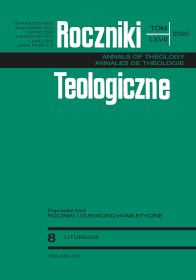In His Church the Lord Opened His Mouth (cf. Eccl. 15,5). Intercession of John the Apostle and Evangelist in Light of Mass Formularies Used in the Western Church Until the Council of Trent
Abstract
From the first centuries the Christian cult of saints has been inseparably linked to the mystery of Christ. Particularly at the beginning, special veneration was given to the Mother of Jesus and to the closest disciples of Christ the Lord. One of these disciples of the Lord, belonging to the Twelve, whose cult has been known since the first centuries of Christianity, is St. John the Evangelist. In western tradition two feastdays are observed in his honor: the day of his birth into heaven, December 27, and the memorial of when he was given over to torture, May 6. Along with the biblical accounts, New Testament apocrypha played an important role in the formation of the cult of St. John. The biblical passages most often used in Mass formulas are the calling of St. John to be a fisher of men, his special relationship with Christ at the Last Supper, and the Mother of the Lord being entrusted into his care. In quoting his teaching, reference is often made to his proclamation of the Eternal Word, Who was with God from the beginning. A reading of the liturgical texts honoring St. John the Evangelist makes it possible to see this saint in the mystery of the Church as a model of union with Christ and with His Mother, and as an intercessor in the daily life of the faithful.
References
Acta Sanctorum Novembris, collecta digesta illustrata, a Carolo de Smedt, Iosepho de Backer, Francisco van Ortroy, Iosepho van den Gheyn, Hippolyto Delehaye & Alberto Poncelet, Societatis Iesu Presbyteris. Tomi II pars prior, qua dies tertius partim et quartus continentur praemissum est Martyrologium Hieronymianum edentibus Iohanne Baptista de Rossi et Ludovico Duchesne, Bruxellis 1894.
Auf der Maur H., Feste und Gedenktage der Heiligen, w: H.B. Meyer (red.), Gottesdienst der Kirche. Handbuch der Liturgiewissenschaft, t. VI/1, Regensburg 1994, s. 67-296.
Boguniowski J.W., Rozwój historyczny ksiąg liturgii rzymskiej do Soboru Trydenckiego i ich recepcja w Polsce, Kraków 2001.
Deshusses J., Le Sacramentaire Gregorien. Ses Principales Formes d’apres les plus anciens Manuscrits, v. 1, Fribourg 1971.
Dold A., Gamber K., Das Sakramentar von Monza (Im cod. F1/101 der dortigen Kapitelsbibliothek), Beuron 1957.
Eizenhöfer L., Siffrin P., Mohlberg L.C., Sacramentarium Veronense (Cod. Bibl. Capit. Veron. LXXXV [80]), Roma 1994.
Franz A., Die kirchlichen Benediktionen im Mittelalter, t. I, Freiburg 1909.
Fros H., Kult świętych w rozwoju historycznym i w liturgii Kościoła, w: tenże, Wprowadzenie do Mszy o świętych, cz. 1, Warszawa 1980, s. 16-101.
Fros H., Sowa F. (opr.), Księga imion i świętych, t. III, Kraków 1998.
Gregorius I, Liber antiphonarius. Ordinatus per circulum anni, PL 78, 641-724.
Gregorius Nyssenus, Oratio funebris qua fratris sui Basilii Magni laudes et memoriam concelebrat, PG 46, 787-818.
Gvillelmi Dvranti Rationale divinorvm officiorvm, VII-VIII, wyd. kryt. A. Davril, T.M. Thibodeau, Turnhout 2000.
Heiming O., Das Sacramentarium Triplex. Die Handschrift C 43 der Zentralbibliothek Zürich, B. I-II, Münster 1968-1983.
Heinz A., Liturgien. IV. Abendländische Liturgien. 2. Altspanische Liturgie, LThK VI, Freiburg im Breisgau 1997, kol. 982-983.
Hesbert R.J., Antiphonale Missarum sextuplex, Rome 1935.
Honorius Augustodunensis, Gemma animae sive de divinis officiis et antiquo ritu missarum, deque horis canonicis et totius annis solemnitatibus, PL 172, 541-737.
Joannes Belethus, Rationale divinorum officiorum, PL 202, 9-166.
Księga Pontyfików 1-96, (Synody i Kolekcje Praw, IX), opr. M. Ożóg, H. Pietras, Kraków 2014.
Leske A., Ewangelia według św. Mateusza, w: Międzynarodowy komentarz do Pisma Świętego, red. W.R. Farmer, Warszawa 2001, s. 1140-1209.
Liturgia mozarabica secundum regulam beati Isidori. Missale Mixtum, PL 85, 109-1055.
Missale Romanum Ex Decreto Sacrosancti Concilii Tridentini restitutum Pii V. Pont. Max. iussu editum, Romae, Apud Hęredes Bartholomęi Faletti, Joannem Uariscum, & Socios, Anno Domini MDLXX.
Missale Romanum ex decreto SS. Concilii Tridentini Restitutum Summorum Pontificum cura recognitum, Editio Typica, Typis Polyglottis Vaticanis 1962.
Mohlberg L.C. (wyd.), Missale Gothicum (Vat. Reg. lat. 317), Roma 1961.
Mohlberg L.C., Liber Sacramentorum Romanae Aeclesiae ordinis anni circuli (Cod. Vat. Reg. lat. 316/Paris Bibl. Nat. 7193, 41/56 Sacramentarium Gelasianum), Roma 1960.
Nadolski B., Galijski ryt, EK V, Lublin 1989, kol. 821-822.
Notkerus Balbulus, Liber sequentiarum, PL 131, 1003-1026.
Pałęcki W., Sakramentarz, EK XVII, Lublin 2012, kol. 901-903.
Righetti M., L’anno Liturgico, (Manuale di storia liturgica, t. II), Milano 1969.
S. Congregatio Rituum, Variationes in Breviario et Missali Romano ad normam novi Codicis Rubricarum, AAS 52(1960), s. 706-721.
Stachowiak L., Jan apostoł Ewangelista. I. W Piśmie św., EK VII, kol. 752-753.
Starowieyski M. (red.), Apokryfy Nowego Testamentu, t. II, cz. I, Kraków 20172.
Straszewicz M., Jan apostoł Ewangelista. II. Kult, EK VII, kol. 753-754.
Św. Augustyn, Homilie na Ewangelie i Pierwszy list Św. Jana, cz. II, (Pisma starochrześcijańskich pisarzy, t. XV), Warszawa 1977.
Wit Z., Troska liturgiczna o człowieka chorego w świetle polskich rytuałów potrydenckich (1631-1964), Lublin 1995.
Copyright (c) 2020 Roczniki Teologiczne

This work is licensed under a Creative Commons Attribution-NonCommercial-NoDerivatives 4.0 International License.





